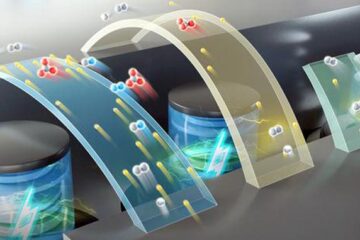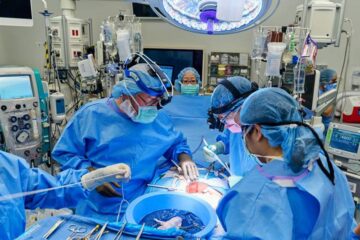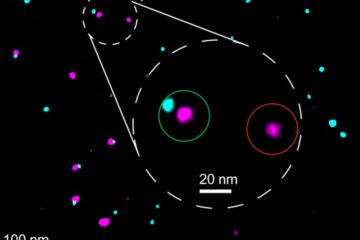Drug developed at Pitt proves effective against antibiotic-resistant 'superbugs'

This is an image of an engineered cationic antimicrobial peptide (eCAP) membrane. Credit: Nicole Davison/UPMC
The findings, announced online in the journal Antimicrobial Agents and Chemotherapy and funded by the National Institutes of Health, provide a needed boost to the field of antibiotic development, which has been limited in the last four decades and outpaced by the rise of drug-resistant bacterial strains.
“Very few, if any, medical discoveries have had a larger impact on modern medicine than the discovery and development of antibiotics,” said senior author Ronald C. Montelaro, Ph.D., professor and co-director of Pitt's CVR. “However, the success of these medical achievements is being threatened due to increasing frequency of antibiotic resistance. It is critical that we move forward with development of new defenses against the drug-resistant bacteria that threaten the lives of our most vulnerable patients.”
Each year in the U.S., at least 2 million people are infected with drug-resistant bacteria, and at least 23,000 die as a direct result of these infections, according to the U.S. Centers for Disease Control and Prevention.
On the tail end of HIV surface protein, there is a sequence of amino acids that the virus uses to “punch into” and infect cells. Dr. Montelaro and his colleagues developed a synthetic and more efficient version of this sequence – called engineered cationic antimicrobial peptides, or “eCAPs”–that can be chemically synthesized in a laboratory setting.
The team tested the two leading eCAPs against a natural antimicrobial peptide (LL37) and a standard antibiotic (colistin), the latter being used as a last-resort antibiotic against multidrug resistant bacterial infections. The scientists performed the tests in a laboratory setting using 100 different bacterial strains isolated from the lungs of pediatric cystic fibrosis patients of Seattle Children's Hospital and 42 bacterial strains isolated from hospitalized adult patients at UPMC.
The natural human antimicrobial peptide LL37 and the colistin drug each inhibited growth of about 50 percent of the clinical isolates, indicating a high level of bacterial resistance to these drugs. In marked contrast, the two eCAPS inhibited growth in about 90 percent of the test bacterial strains.
“We were very impressed with the performance of the eCAPs when compared with some of the best existing drugs, including a natural antimicrobial peptide made by Mother Nature and an antibiotic of last resort,” said Dr. Montelaro. “However, we still needed to know how long the eCAPs would be effective before the bacteria develop resistance.”
The team challenged a highly infectious and pathogenic bacterium called Pseudomonas aeruginosa – which flourishes in medical equipment, such as catheters, and causes inflammation, sepsis and organ failure – with both the traditional drugs and eCAPs in the lab.
The bacterium developed resistance to the traditional drugs in as little as three days. In contrast, it took 25 to 30 days for the same bacterium to develop resistance to the eCAPs. In addition, the eCAPs worked just as effectively at killing Pseudomonas aeruginosa after it became resistant to the traditional drugs.
“We plan to continue developing the eCAPs in the lab and in animal models, with the intention of creating the least-toxic and most effective version possible so we can move them to clinical trials and help patients who have exhausted existing antibiotic options,” said Dr. Montelaro.
Additional researchers on this study are Berthony Deslouches, M.D., Ph.D., Jonathan D. Steckbeck, Ph.D., M.B.A., Jodi K. Craigo, Ph.D., and Yohei Doi, M.D., all of Pitt; and Jane L. Burns, M.D., of Seattle Children's Research Institute.
This research was supported by NIH grants P30DK072506, R01AI104895, R21AI107302 and P30 DK089507, as well as funds from Pitt's Center for Vaccine Research and Cystic Fibrosis Research Center.
About the University of Pittsburgh Schools of the Health Sciences
The University of Pittsburgh Schools of the Health Sciences include the schools of Medicine, Nursing, Dental Medicine, Pharmacy, Health and Rehabilitation Sciences and the Graduate School of Public Health. The schools serve as the academic partner to the UPMC (University of Pittsburgh Medical Center). Together, their combined mission is to train tomorrow's health care specialists and biomedical scientists, engage in groundbreaking research that will advance understanding of the causes and treatments of disease and participate in the delivery of outstanding patient care. Since 1998, Pitt and its affiliated university faculty have ranked among the top 10 educational institutions in grant support from the National Institutes of Health. For additional information about the Schools of the Health Sciences, please visit http://www.health.pitt.edu .
Media Contact
All latest news from the category: Life Sciences and Chemistry
Articles and reports from the Life Sciences and chemistry area deal with applied and basic research into modern biology, chemistry and human medicine.
Valuable information can be found on a range of life sciences fields including bacteriology, biochemistry, bionics, bioinformatics, biophysics, biotechnology, genetics, geobotany, human biology, marine biology, microbiology, molecular biology, cellular biology, zoology, bioinorganic chemistry, microchemistry and environmental chemistry.
Newest articles

High-energy-density aqueous battery based on halogen multi-electron transfer
Traditional non-aqueous lithium-ion batteries have a high energy density, but their safety is compromised due to the flammable organic electrolytes they utilize. Aqueous batteries use water as the solvent for…

First-ever combined heart pump and pig kidney transplant
…gives new hope to patient with terminal illness. Surgeons at NYU Langone Health performed the first-ever combined mechanical heart pump and gene-edited pig kidney transplant surgery in a 54-year-old woman…

Biophysics: Testing how well biomarkers work
LMU researchers have developed a method to determine how reliably target proteins can be labeled using super-resolution fluorescence microscopy. Modern microscopy techniques make it possible to examine the inner workings…





















